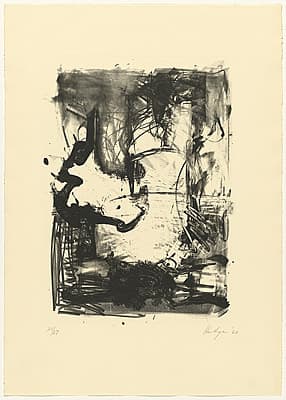
Grace
HARTIGAN
United States of America
1922
–
2008
ULAE
printer
United States of America
1960
The hero
1960
planograph
lithograph
on paper
21/27
In p. l.l. 21/27. In p. l.r. Hartigan '60. Embossed l.l. ULAE.
comp
51.4 (h)
x 38.0 (w)
cm
sheet
75.6 (h)
x 54.0 (w)
cm
Purchased 1984
National Gallery of Australia, Canberra
NGA 1984.2975.2
Grace Hartigan’s suite of four lithographs, The hero leaves the ship 1960, was inspired by a poem of the same name by Barbara Guest, and published by the fine art print publisher ULAE. The artist was unfamiliar with the process of lithography:
I had never done lithos and knew nothing … after a week stalking the stones, I plunged in with splatters of tusche, free drawing, rubbing, pounding with hands and with rags and did four lithos…[1]
The astounding spontaneity of gesture and freedom of stroke seen in this series can perhaps be attributed to Hartigan’s engagement with a new technique. Combining imagery suggestive of a ship with atmospheric finger markings, splatters and rubbings, the works are both lyrical and vigorous.
Although Hartigan sees herself primarily as a colourist, she is adept at manipulating her lithographs to draw out a variety of textures and tones. In The ship (3) she evokes the translucence of watercolour alongside intense purposeful line drawing and the dark mottling effect of her own fingerprint. The lithographs merge figuration with abstraction, a characteristic that endures in the artist’s later work.
Gadia Zrihan
[1] Grace Hartigan comments on her first lithographs: Special Collections Research Center, Syracuse University Library, http://library.syr.edu/digital/exhibits/i/imagine/section8.htm (accessed June 2012)
Discussion of the work
Grace Hartigan’s suite of four lithographs, The hero leaves the ship 1960, was inspired by a poem of the same name by Barbara Guest, and published by the fine art print publisher ULAE. The artist was unfamiliar with the process of lithography:
I had never done lithos and knew nothing … after a week stalking the stones, I plunged in with splatters of tusche, free drawing, rubbing, pounding with hands and with rags and did four lithos…[1]
The astounding spontaneity of gesture and freedom of stroke seen in this series can perhaps be attributed to Hartigan’s engagement with a new technique. Combining imagery suggestive of a ship with atmospheric finger markings, splatters and rubbings, the works are both lyrical and vigorous.
Although Hartigan sees herself primarily as a colourist, she is adept at manipulating her lithographs to draw out a variety of textures and tones. In The ship (3) she evokes the translucence of watercolour alongside intense purposeful line drawing and the dark mottling effect of her own fingerprint. The lithographs merge figuration with abstraction, a characteristic that endures in the artist’s later work.
Gadia Zrihan
[1] Grace Hartigan comments on her first lithographs: Special Collections Research Center, Syracuse University Library, http://library.syr.edu/digital/exhibits/i/imagine/section8.htm (accessed June 2012)
